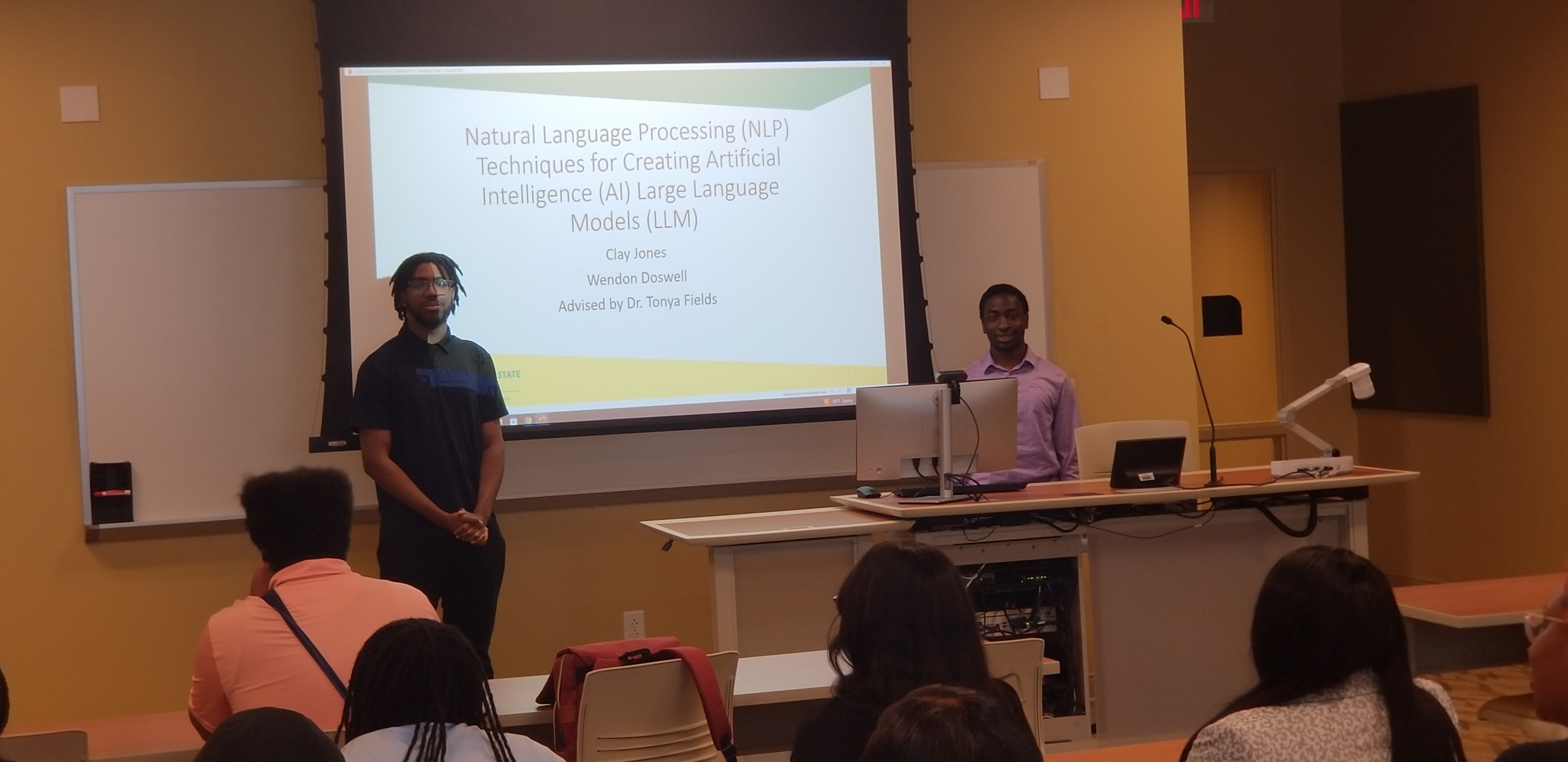Over Summer 2024, five students funded by the ACTION grant participated in the 2024 Summer Research Program hosted by the College of Science, Engineering, & Technology at Norfolk State University.
Not included below is a project by Atrell Williams titled "AI & Deep Fakes in Social Media." Atrell is a Mass Communication Major advised by Dr. Dr. Tonya Fields.
Some Implications of ChatGPT for Cybersecurity
Korey Bailey
Research Advisors: Dr. Fields and Dr. Hoppa
Abstract
ChatGPT, an Artificial Intelligence-driven chatbot developed by OpenAI, uses natural language processing to generate human-like text and has garnered widespread adoption since its inception. While it offers numerous benefits – including question answering, code creation, and report generation – ChatGPT’s capabilities also raise concerns regarding potential cybersecurity risks. This paper provides context to the discussion by sharing the results of several experiments that show how ChatGPT can be used to enable or defend against cyber attacks. It also confirms previously reported findings that ChatGPT’s built-in security mechanisms – intended to discourage malicious use – are easily bypassed. Staying informed about the implications of generative Artificial Intelligence like ChatGPT is essential for effectively addressing new security challenges, developing robust defenses, and ensuring responsible and ethical AI usage within the field of cybersecurity.
Keywords: cybersecurity, Natural Language Processing, Large Language Model, generative Artificial Intelligence, risks.
Paper Submitted for Review Submitted to: CFP: Artificial Intelligence + Data
Science. (CSCI'24 Conference: Dec. 11-13, 2024; Las Vegas, USA);
Mr. Korey Bailey
Cybersecurity Graduate, May 2024
Norfolk State University
Modeling and Simulation of Cyber-Physical System with UPPAAL: A Case
Study of an Automotive Brake System
Timothy Agboada
Research Advisor: Dr. Jules Chenou
Abstract
Safety holds paramount importance in the automotive industry. Regardless of a vehicle’s power or aesthetic appeal, its foremost function is transporting passengers safely from one point to another. With rapid advancements in automotive technology, there has been a corresponding rise in cyber-attacks targeting the electronically connected components of vehicles, particularly the braking systems. This paper presents a comprehensive study on verifying a model that integrates an intrusion detection system (IDS) designed to identify and mitigate potential cyber-attacks, thereby ensuring the safety and convenience of vehicle occupants. The system is meticulously modeled using UPPAAL, a sophisticated tool for modeling, validating, and verifying real-time systems. This model simulates various components of the Autonomous Braking System (ABS) within a vehicle, demonstrating how the IDS can effectively detect and counteract security threats before they compromise the safety of the passengers. Through detailed simulations and validations, this study aims to provide a robust framework for enhancing the security measures in modern
automotive systems, ultimately contributing to the development of safer, more resilient vehicles.
Keywords: UPPAAL, Real-Time Systems, Timed Automata, Formal Verification,
Simulation, Embedded Systems, Cyber-Physical System (CPS), Automotive
Brake System (ABS), Safety, Reliability.
Mr. Timothy Agboada
Projected M.S., Dec 2024
Norfolk State University
Self-Adaptive Petri Net for Detection of Malware Intrusion
Jasmine McDuffie
Research Advisor: Dr. Jules Chenou
Abstract
The main purpose of this report is to provide information on Petri nets, including their, design, semantics, properties, and uses. The problem addressed is how to model and analyze systems that may be susceptible to unknown issues. By visualizing these issues, we can improve or modify the system. Petri nets are highly powerful tools that can solve several problems, including issues with workflow management, deadlock, data transmission in communication systems, manufacturing and production, software systems, and more. These things are widely used in different work fields such as engineering, project management, and computer science. It is important to solve these problems for maintaining system reliability, and optimal performance. Exploring all the uses and techniques of a Petri net, beginning with the basics and advancing to the more
complex ideas, demonstrates just how effective they are. The results confirm that Petri nets are important for identifying systems that need improvement within their performance and components across multiple fields.
Keywords: Petri nets, semantics, workflow management, deadlock, data transmission, communication systems, manufacturing, production, reliability, performance.
Ms. Jasmine McDuffie
Norfolk State University
Natural Language Processing Techniques for Creating Large Language Models
Wendon Doswell and Clay Jones
Research Advisor: Dr. Tonya Fields
Abstract
Machines do not understand raw text, text needs to be represented numerically through vectors. Natural Language Processing (NLP) is a branch of artificial intelligence (AI) that trains machine learning (ML) models to understand, generate, and manipulate human language. This research explored NLP techniques to create word vectors and word embeddings to train ML models.
Mr. Wendon Doswell
Norfolk State University
Mr. Clay Jones
Norfolk State University





